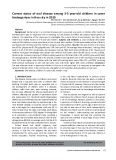
77
Journal of Medicine and Pharmacy, Volume 11, No.07/2021
Current status of oral disease among 3-5 year-old children in some
kindergartens in Hue city in 2019
Tran Tan Tai 1*, Tran Thi Kim Anh1, Ho Sy Minh Duc 1, Nguyen Thi Tan2
(1) Faculty of Odonto Stomatology, Hue University of Medicne and Pharmacy, Hue University, Vietnam
(2) Hue University of Medicne and Pharmacy, Hue University, Vietnam
Abstract
Background: Dental caries is a common disease and is acquired very early in children after teething.
Primitive teeth play an important role in chewing, so oral disease will affect the physical development of
children. The objective of the study was to investigate the current status of oral disease, the role of the
mother and related factors of 3-5 year-old children. Subjects and methods: A cross-sectional descriptive
study of 524 children in some preschools in Hue city and their mothers. Clinical examination of the children’s
oral health and interview with the mothers using to a set of questions. Results: The rate of caries in 4 schools
was 70.6%, plaque was 82.3%, gingivitis was 7.3%. with p>0.05. The average index of decayed, missing, filled
teeth is 3.43, 0.19; 0.97, respectively; the decayed, missing, filled teeth index (dmft) was 4.59. The group of
mothers with good knowledge and practice had children with lower caries (65.8% versus 75.7%, p<0.05).
Dental caries increases in group of children eating sweets by 2.29 times (OR= 2.29; p<0.01), group with habit
of sucking food by 1.76 times (OR=1.76; p<0.05), children brushing teeth only in the morning or evening had
risks 2.27 times higher than children with the habit of brushing teeth twice (OR=2.27; p<0.001), brushing
teeth without toothpaste or with salt had caries risks 4.36 times higher (OR =4.36; p<0.001). Conclusion:
The rate of dental caries in preschool children in Hue city is still quite high. It is necessary to strengthen the
network of dental clinics in the community, strengthen communication and education on oral care.
Keywords: Oral disease, children 3-5 years old, mother’s role.
1. INTRODUCTION
Oral disease, mainly caries, in children is a common
disease and is acquired very early in children after
teething. Primitive teeth play an important role in
the development of children, when it is decayed,
children suffer from pain, poor chewing, anorexia,
loss of sleep, affecting the physical development of
children, affecting the position of permanent teeth
and malocclusion [1]. The World Health Organization
(WHO) has recommended that the implementation of
early oral disease prevention at preschool age is the
most feasible strategy in countries around the world
and in the region for many decades until now [2]. In
order to determine the state of primitive tooth decay
in Vietnamese children in 2019, Nguyen Thi Hong Minh
et al conducted a cross-sectional study, recording a
very high rate of primitive tooth decay in the 6-8 year-
old age group (86.4%), on average, each child has 6.21
decayed teeth and the rate of treated teeth is low [3].
School based oral health programs have
developed in all 64 provinces and cities across the
country. In Hue city, this program has also been
implemented for many years with the content of
dental education, fluoride mouthrising, however,
it has only been implemented in primary school
students. Recently, there has also been a number of
research projects on oral diseases in preschool aged
3-5 years old [4]. However, there are very few studies
focusing on assessing the relationship between the
rate of oral disease and the knowledge and attitudes
of mothers.
How to practice oral hygiene as well as prevent
tooth decay for children from 3-5 years old depends
a lot on knowledge, attitude, practice in instruction,
supervision of children’s brushing, periodical dental
examination for children. At this age, children are not
yet able to take care of their teeth independently.
Effective oral health care for children must be based
on the mother’s understanding and educational
knowledge. It means learning and choosing the
right oral care method in each stage of your child’s
development [5].
In order to have a basis to evaluate and proactively
propose effective measures to improve oral health
at preschool age in Hue city, the aim of the study is
to survey the current state of oral disease, mother’s
role and related factors of 3-5 year old children in
some kindergartens in Hue city.
Corresponding author: Tran Tan Tai; email: tttai@huemed-univ.edu.vn
Received: 15/11/2021; Accepted: 20/12/2021; Published: 30/12/2021
DOI: 10.34071/jmp.2021.7.10





















